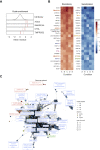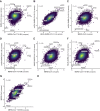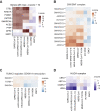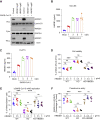Genome-wide CRISPR Screens Reveal Host Factors Critical for SARS-CoV-2 Infection
- PMID: 33147444
- PMCID: PMC7574718
- DOI: 10.1016/j.cell.2020.10.028
Genome-wide CRISPR Screens Reveal Host Factors Critical for SARS-CoV-2 Infection
Abstract
Identification of host genes essential for severe acute respiratory syndrome coronavirus 2 (SARS-CoV-2) infection may reveal novel therapeutic targets and inform our understanding of coronavirus disease 2019 (COVID-19) pathogenesis. Here we performed genome-wide CRISPR screens in Vero-E6 cells with SARS-CoV-2, Middle East respiratory syndrome CoV (MERS-CoV), bat CoV HKU5 expressing the SARS-CoV-1 spike, and vesicular stomatitis virus (VSV) expressing the SARS-CoV-2 spike. We identified known SARS-CoV-2 host factors, including the receptor ACE2 and protease Cathepsin L. We additionally discovered pro-viral genes and pathways, including HMGB1 and the SWI/SNF chromatin remodeling complex, that are SARS lineage and pan-coronavirus specific, respectively. We show that HMGB1 regulates ACE2 expression and is critical for entry of SARS-CoV-2, SARS-CoV-1, and NL63. We also show that small-molecule antagonists of identified gene products inhibited SARS-CoV-2 infection in monkey and human cells, demonstrating the conserved role of these genetic hits across species. This identifies potential therapeutic targets for SARS-CoV-2 and reveals SARS lineage-specific and pan-CoV host factors that regulate susceptibility to highly pathogenic CoVs.
Keywords: COVID-19; CRISPR screen; Epigenetics; HMGB1; MERS-CoV; Middle East Respiratory Syndrome; SARS-CoV-2; SWI/SNF complex; Severe Acute Respiratory Syndrome.
Copyright © 2020 Elsevier Inc. All rights reserved.
Conflict of interest statement
Declaration of Interests Yale University (C.B.W.) has a patent pending related to this work entitled “Compounds and Compositions for Treating, Ameliorating, and/or Preventing SARS-CoV-2 Infection and/or Complications Thereof.” Yale University has committed to rapidly executable non-exclusive royalty-free licenses to intellectual property rights for the purpose of making and distributing products to prevent, diagnose, and treat COVID-19 infection during the pandemic and for a short period thereafter. J.G.D. consults for Foghorn Therapeutics, Maze Therapeutics, Merck, Agios, and Pfizer. J.G.D. consults for and has equity in Tango Therapeutics. C.K. is the Scientific Founder, Board of Directors member, Scientific Advisory Board member, shareholder, and consultant for Foghorn Therapeutics, Inc. (Cambridge, MA).
Figures













Update of
-
Genome-wide CRISPR screen reveals host genes that regulate SARS-CoV-2 infection.bioRxiv [Preprint]. 2020 Jun 17:2020.06.16.155101. doi: 10.1101/2020.06.16.155101. bioRxiv. 2020. Update in: Cell. 2021 Jan 7;184(1):76-91.e13. doi: 10.1016/j.cell.2020.10.028. PMID: 32869025 Free PMC article. Updated. Preprint.
Comment in
-
Host genetics of coronavirus infection.Nat Rev Genet. 2021 Jan;22(1):1. doi: 10.1038/s41576-020-00310-y. Nat Rev Genet. 2021. PMID: 33235360 Free PMC article.
-
A Crisp(r) New Perspective on SARS-CoV-2 Biology.Cell. 2021 Jan 7;184(1):15-17. doi: 10.1016/j.cell.2020.12.003. Epub 2020 Dec 17. Cell. 2021. PMID: 33338422 Free PMC article.
References
-
- Andersson U., Yang H., Harris H. High-mobility group box 1 protein (HMGB1) operates as an alarmin outside as well as inside cells. Semin. Immunol. 2018;38:40–48. - PubMed
Publication types
MeSH terms
Substances
Grants and funding
- R01 AI123449/AI/NIAID NIH HHS/United States
- T32 AI007019/AI/NIAID NIH HHS/United States
- T32 GM007223/GM/NIGMS NIH HHS/United States
- UL1 TR001863/TR/NCATS NIH HHS/United States
- F30 HL149151/HL/NHLBI NIH HHS/United States
- R01 AI148467/AI/NIAID NIH HHS/United States
- R21 AI157835/AI/NIAID NIH HHS/United States
- T32 GM007205/GM/NIGMS NIH HHS/United States
- F31 AI54739 /AI/NIAID NIH HHS/United States
- P50 CA121974/CA/NCI NIH HHS/United States
- K08 AI128043/AI/NIAID NIH HHS/United States
- R01 AI087925/AI/NIAID NIH HHS/United States
- F31 DA054739/DA/NIDA NIH HHS/United States
- U19 AI133524/AI/NIAID NIH HHS/United States
- T32 CA193200/CA/NCI NIH HHS/United States
- R00 DK116666/DK/NIDDK NIH HHS/United States
- F31 AI154739/AI/NIAID NIH HHS/United States
- P50 CA196530/CA/NCI NIH HHS/United States
LinkOut - more resources
Full Text Sources
Other Literature Sources
Molecular Biology Databases
Research Materials
Miscellaneous

